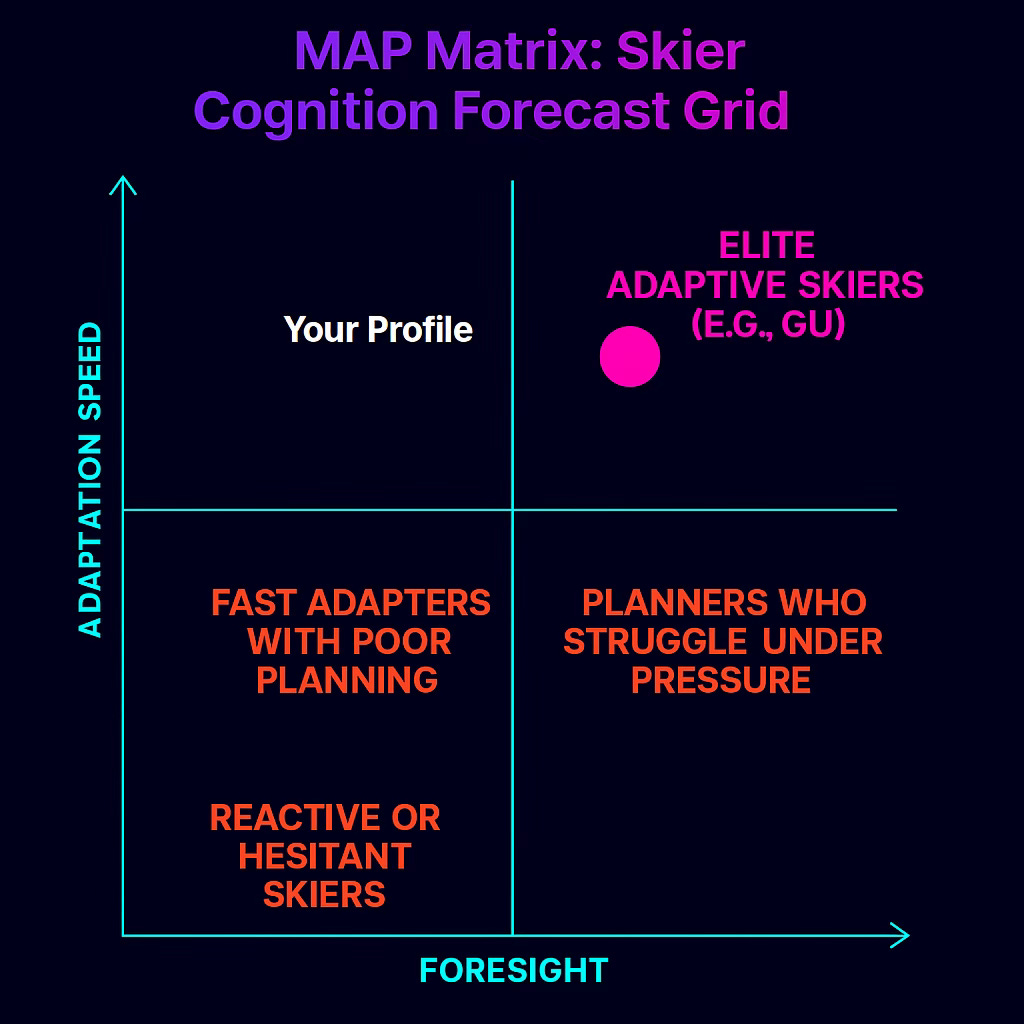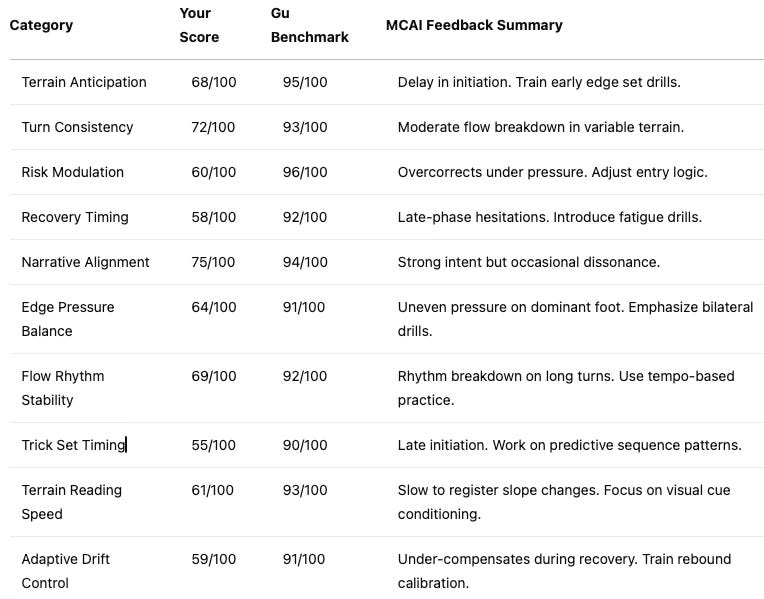MCAI Ski Vision: Edge Intelligence
Snow Terrain as Forecasting Environment: Skiing, Risk, and Real-Time Cognitive Adaptation
I. Introduction: Slope as Simulation
Skiing compresses decision-making into milliseconds. A skier descending a slope reads terrain, calculates speed, and adjusts posture without conscious deliberation. Each turn becomes a decision node. Each adjustment reflects a prediction. In skiing, the body forecasts, reacts, and recalibrates in real time.
MCAI is a form of Cognitive Artificial Intelligence—a system that simulates judgment, prediction, and adaptation in real time using structured behavioral data. Its proprietary tools (patent pending) include the MCAI Cognitive Digital Twin(CDT), which models individual judgment and decision structure, and the MCAI Forecast Engine, which simulates adaptive responses under real-world constraint. These tools integrate through MCAI Forecast, ALI (Action-Language Integrity), CMF (Cognitive-Motor Fidelity), and domain-specific Vision Functions. In this paper, MCAI applies its forecasting architecture to skiing, using sensor data to map decision fluency and adaptive intelligence.
Skiing compresses decision-making into milliseconds. A skier descending a slope reads terrain, calculates speed, and adjusts posture without conscious deliberation. Each turn becomes a decision node. Each adjustment reflects a prediction. In skiing, the body forecasts, reacts, and recalibrates in real time.
Modern ski monitoring technology reveals this loop with precision. Platforms like Carv and Snowcookie generate data streams—edge pressure, turn symmetry, G-force modulation—that expose cognitive patterns under motion. Skiing becomes more than sport. It becomes a terrain-based test of adaptive intelligence.
II. The Predictive Brain on Snow
Forecasting under uncertainty defines intelligence. The skier moves through an unstructured environment, navigating snow texture, gradient shifts, and velocity. Success depends on anticipation, not reaction. The brain runs a continuous loop: What’s ahead? How should I adjust?
Turn sequences reflect Bayesian reasoning. Each movement updates the internal model. A tighter turn signals snow resistance. A delayed edge sets up for unpredictability. The skier integrates data from vision, proprioception, and memory to refine action.
The slope becomes a canvas for real-time hypothesis testing. Missed forecasts result in overcorrections or falls. Clean lines suggest convergence between internal model and terrain reality.
III. Wearable Tech as Cognitive Instrument
Wearables transform skiing into a measurable cognitive lab. Devices like Carv measure edge angle, turn duration, vertical load, and stance symmetry. Snowcookie captures body motion in 3D. Together, they provide a feedback loop previously hidden from analysis.
These tools translate physical movement into cognitive signature. Does the skier commit early or delay under uncertainty? Do they adjust mid-turn or default to habit? Fatigue, slope texture, and prior error all shape moment-by-moment decisions.
The body acts as a forecast model. Sensor data becomes the language of its output.
IV. Risk Modulation and Adaptive Logic
Each skier manages risk in real time. The aggressive skier charges forward, trusting prediction over caution. The hesitant skier brakes and delays, compensating for lower certainty. Monitoring tech captures these choices.
Turn shape reflects risk strategy. Sharp entries with high pressure signal overcommitment. Delayed edge sets reveal hedging. Fatigue compounds error rates. Skilled skiers recalibrate, preserving flow. Others spiral—reacting, tightening, falling out of line.
This real-time modulation mirrors executive function. Risk appetite, cognitive flexibility, and decision resilience all express through skis and sensors.
V. The MCAI Forecast Layer: Modeling Ski Cognition
MCAI’s Forecast engine models skier cognition using forecast trees and probability deltas. Every run becomes a time series of expectation vs. outcome.
Turn 1: Forecast smooth terrain → Outcome: unexpected ice → Result: edge slip → Adjustment: wider turn in Turn 2.
These adjustments reveal the skier’s update logic. Do they incorporate new information quickly? Do they adjust at optimal risk thresholds? The MCAI Forecast Engine simulates future behavior based on observed error integration.
MCAI Forecast tags each turn with decision markers:
Anticipatory vs. Reactive
Conservative vs. Committed
Adjustment latency (ms)
Using telemetry data, the engine builds a cognitive forecast profile—one that predicts skier choices under fatigue, pressure, or novel terrain.
VI. Behavioral Style Profiles: Cognitive Fingerprints in Motion
Skiers exhibit distinct decision archetypes. Wearable data uncovers these styles:
The Planner – anticipates terrain early, commits to clean arcs, recalibrates with minimal error.
The Improviser – adjusts on the fly, tolerates instability, succeeds through fluid recovery.
The Hesitator – delays decision points, over-brakes, struggles with flow.
The Over-Committer – charges early, misjudges risk, prone to crash under misread conditions.
Each profile reflects a mental model of control and risk. Some skiers perform consistently. Others show narrative drift—their style shifts under stress. MCAI’s ALI module detects divergence between self-narrative and data-confirmed behavior.
Ski telemetry becomes a behavioral truth serum.
VII. SkiVision Case Study: Eileen Gu
Gu exhibits ultra-high decision fluency. Her trick sequencing in Big Air reflects real-time risk forecasting under narrative pressure. She adjusts strategy based on scoring heuristics, weather, and competitor behavior—applying recursive updates during the same run.
Forecast Engine Profile: Gu’s turns show anticipatory risk modulation. She commits early, adapts with mid-air recalibration, and optimizes for flow integrity. Her behavior clusters in the upper-right quadrant of the MCAI Forecast Matrix: high foresight, high adaptation.
ALI/CMF Scores: Her action matches her language. Gu speaks of confidence, control, and creativity—and delivers them precisely. Her motor decisions mirror internal calibration. No narrative drift. High integrity. High fidelity.
Blueprint for Emulation: MCAI can translate telemetry from ski monitoring platforms directly into personalized cognitive forecasts. By analyzing edge control, turn dynamics, and adaptation latency, MCAI identifies a skier’s current decision profile and outputs a clear set of next steps to align with Eileen Gu’s predictive performance style. Skiers receive targeted feedback—adjustment frequency, timing precision, flow continuity—matched to their own data signatures. The result is a tailored cognitive blueprint: a roadmap to ski like Gu based on the realities of your motion.
Skiers using monitoring tools like Carv, Snowcookie, or PIQ can model their approach on Gu’s strategy. Key behavioral targets include:
Anticipate terrain: Initiate adjustments early. Track edge pressure and turn timing to assess whether you act before terrain demands reaction. Anticipatory skiers read the slope like a forecast chart—spotting compression zones, uneven snow, or variable incline before they encounter them. MCAI flags delays between visual cue and motor output, then recommends feedback drills to shorten latency and improve proactive execution.
Calibrate flow: Aim for high turn consistency and symmetry, minimizing mid-run overcorrection. Gu’s runs exhibit near-identical turn shapes under pressure, suggesting rhythmic motor programming. MCAI tracks deviation in stance, G-force variability, and centerline drift to quantify flow deterioration—then provides slope-specific corrections to recover fluidity without losing aggression.
Risk adaptation: Monitor G-force spikes and stance shifts during trick setups or complex terrain. Train to recalibrate—not react—under stress. Gu displays seamless recovery logic—tightening core control without sacrificing momentum. MCAI compares your recovery patterns to hers, identifying whether your body overcorrects, locks up, or rebounds cleanly. Adaptive logic drills follow.
Cognitive resilience: Use fatigue markers (e.g., longer reaction latency, reduced stance control) as cues to test flow integrity, not as failure points. MCAI flags when fatigue distorts your forecast calibration. It trains skiers to recognize physiological drift and build routines that preserve decision clarity late in runs—mirroring Gu’s consistent late-stage performance.
Narrative alignment: Match your behavior to your stated goals. Use post-run data to assess if your performance tells the story you believe about your skiing. Gu’s identity—confident, strategic, elegant—is embedded in her motion. MCAI applies ALI scoring to assess whether your movement communicates intention or dissonance. If your skiing contradicts your self-narrative, targeted interventions help restore alignment.
Edge pressure balance: Monitor bilateral symmetry through force distribution. Gu’s baseline symmetry allows efficient energy transfer and dynamic edge release. MCAI uses force plates and stance mapping to detect dominant-foot bias and provides drills to equalize input and reduce compensatory tension.
Flow rhythm stability: Evaluate the temporal spacing of turns and recoveries. MCAI captures rhythm drift as an early indicator of overthinking, fear, or fatigue. Skiers who struggle to maintain rhythm often break cognitive sequencing. Prescribed tempo-based exercises restore motor alignment with forecast cadence.
Trick set timing: Assess pre-takeoff flow and decision latency. Gu times her tricks with terrain cue alignment and low hesitation. MCAI uses motion sensors to map your trick initiation lag and spatial preparation. Training includes predictive commitment sequences—transition timing drills that reduce pre-trick hesitation.
Terrain reading speed: Track the rate at which visual stimuli lead to motor action. MCAI calculates visual-processing-to-execution latency, especially in mixed terrain. Skiers who lag behind environmental changes get targeted visual scanning routines and front-loaded reaction simulations.
Adaptive drift control: Measure your response to unplanned shifts—ice patches, wind gusts, unbalanced landings. MCAI tracks center of mass stabilization and drift recovery metrics. Gu controls drift without tension, using core recalibration. You’ll receive recommendations for slow-burn, low-friction edge work and dynamic stance drills to smooth corrections.
Summary: SkiVision identifies Gu as a Mozart 2.0 Effect profile—layered cognition under constraint, mirrored perfectly in motion. Read more on the Mozart 2.0 Effect. She is not simply a high-skill athlete. She is a forecasting machine in human form.
Sample MCAI SkiVision Scorecard:
This scorecard is not a static report—it is generated by the MCAI Forecast Engine, which uses your telemetry data to simulate your cognitive decision loop in motion. It is AI, personalized.
This sample scorecard provides a real-time roadmap to help skiers close the gap with Gu’s performance profile. MCAI integrates live data with forecast logic to generate tailored drills, performance thresholds, and flow recalibration points—bringing elite-level cognition within reach.
VIII. Applications Beyond the Slopes
Edge intelligence extends beyond skiing. MCAI itself is AI—it does not generate generic responses or statistical summaries. It simulates the structure of judgment, converting data into adaptive models of how decisions evolve under constraint. In AI applications, terrain-based adaptation teaches machines how to forecast under fluid constraint. In performance coaching, skiing becomes a diagnostic tool—revealing how leaders or professionals manage risk, recover from error, or maintain momentum.
In behavioral economics, slope telemetry offers a real-world model of bounded rationality. Skiers don’t optimize in theory—they adapt in motion, within constraints. Their decisions reflect cost-benefit compression, friction adjustment, and resilience under entropy.
Skiing thus serves as a training ground for executive decision-making in fields far from the mountain.
IX. Conclusion: Forecasting as Identity
Skiing reveals how people forecast, adjust, and persist. Movement becomes thought made visible. With data from wearables, we can model not just skill, but how individuals think under speed, pressure, and noise.
Forecasting is not an abstraction—it’s a physical act. On the slope, uncertainty is constant. The skier must project a belief, commit to it, and update rapidly when wrong. Forecasting becomes an embodied feedback system, where clarity, timing, and trust determine whether the skier stays in flow or loses the line.
MCAI turns those runs into models. It doesn’t simply score performance; it identifies forecast structure, adaptation cadence, and judgment integrity. Skiing offers a rare moment when the full spectrum of cognition, emotion, and resilience surfaces in observable form. And because the slope is indifferent—always revealing and never forgiving—it becomes the perfect testbed for forecasting under constraint.
Edge intelligence isn’t about skiing. It’s about uncovering the mind’s ability to act fluidly and decisively in dynamic environments. The mountain, with its volatility and momentum, exposes the difference between knowing the path and skiing it.
X. About the Author
Noel Le is the founder and architect of MCAI (MindCast Artificial Intelligence), a predictive cognitive simulation platform designed to decode judgment, decision-making, and behavioral foresight. Noel holds a J.D., with a concentration in law and economics and behavioral economics. He developed MCAI after realizing the lack of a predictive mechanism in behavioral economics (despite two Nobel prizes in the domain). His work spans litigation risk modeling, economics forecasting, narrative analysis, and high-performance cognitive systems. He created MCAI to scale decision fluency and simulate adaptive intelligence in environments where judgment matters most—from courtrooms to ski slopes.
You can follow his latest work at noelleesq.substack.com. Connect with him professionally on LinkedIn.




